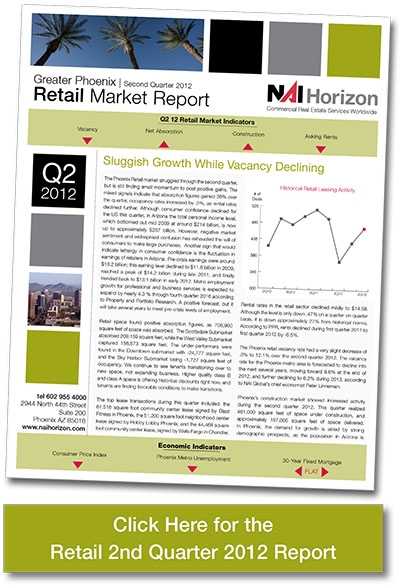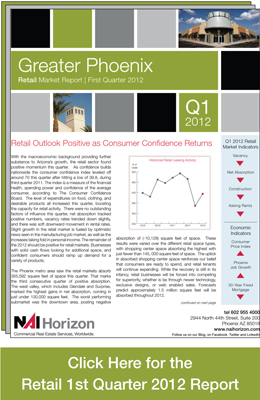The Phoenix Retail market struggled through the second quarter, but is still finding small momentum to post positive gains. The mixed signals indicate that absorption figures gained 36% over the quarter, occupancy rates increased by .3%, as rental rates declined further. Although consumer confidence declined for the US this quarter, in Arizona the total personal income level, which bottomed out mid 2009 at around $214 billion, is now up to approximately $237 billion. However, negative market sentiment and widespread confusion has exhausted the will of consumers to make large purchases. Another sign that would indicate lethargy in consumer confidence is the fluctuation in earnings of retailers in Arizona. Pre-crisis earnings were around $13.2 billion; this earning level declined to $11.6 billion in 2009, reached a peak of $14.2 billion during late 2011, and finally trended back to $13.1 billion in early 2012. Metro employment growth for professional and business services is expected to expand by nearly 4.3 % through fourth quarter 2016 according to Property and Portfolio Research. A positive forecast, but it will take several years to meet pre-crisis levels of employment.
Retail space found positive absorption figures, as 706,900 square feet of space was absorbed. The Scottsdale Submarket absorbed 209,159 square feet, while the West Valley Submarket captured 156,573 square feet. The under-performers were found in the Downtown submarket with -24,777 square feet, and the Sky Harbor Submarket losing -1,727 square feet of occupancy. We continue to see tenants transitioning over to new space, not expanding business. Higher quality class B and class A space is offering historical discounts right now, and tenants are finding favorable conditions to make transitions.
The top lease transactions during this quarter included: the 61,518 square foot community center lease signed by Blast Fitness in Phoenix, the 51,200 square foot neighborhood center lease signed by Hobby Lobby Phoenix, and the 44,468 square foot community center lease, signed by Wells Fargo in Chandler. Rental rates in the retail sector declined mildly to $14.58. Although the level is only down .47% on a quarter-on-quarter basis, it is down approximately 27% from historical norms. According to PPR, rents declined during first quarter 2011 to first quarter 2012 by -6.5%.
The Phoenix retail vacancy rate had a very slight decrease of .3% to 12.1% over the second quarter 2012. The vacancy rate for the Phoenix metro area is forecasted to decline into the next several years, moving toward 9.6% at the end of 2012, and further declining to 6.2% during 2013, according to NAI Global’s chief economist Peter Linneman.
Phoenix’s construction market showed increased activity during the second quarter 2012. This quarter realized 461,000 square feet of space under construction, and approximately 197,000 square feet of space delivered. In Phoenix, the demand for growth is aided by strong demographic prospects, as the population in Arizona is projected to expand 2.5% through 2015. The Phoenix Retail sector will eventually cycle back to pre-crisis levels; it will take time to work through the indecisiveness and market fluctuations throughout the US. With such a troubling fiscal situation, and utter misperception about current market standing, individuals have scaled back on purchasing goods.
On a national scale, during 2006 and 2007, demand for retail space approached 2.4%, while supply was making advances nearing 1.5%. Conversely, during mid 2008 through mid 2011, demand bottomed out to approximately -.5%, supply was basically nonexistent and vacancy levels peaked above 13%. However, we are making progress as demand is positive, and vacancy levels find the lower 12% range. The momentum needed to balance the uptake in distressed debt must make serious advances. From early 2005 until later 2008, the volume of delinquent commercial mortgage-backed securities found levels around $5 billion. At issue is the current level of delinquent mortgages. In April 2012 the volume had risen to $58.4 billion. Such escalations have drastically brought down rental rates as renegotiated mortgages, under the original value, allow owners to scale back leasing rates.
Throughout the US, cap rates for the retail sector have remained at flat levels, averaging 7.17% through April 2012. Levels spiked up to 7.88% during 2009, but have trended back down to the high 6% – low 7% level. While the volume of sales for retail properties nationwide was in the $50 billion range pre crisis, during 2011 $39.8 billion in sales was noticed. Furthermore, during 2004 and 2005, the US retail market saw returns nearing 20%. While we bottomed out during the second quarter of 2009 at -12.5%, progress is still contained as fourth quarter 2011 recorded returns just under 10%. In perspective, the US lost a lot of ground throughout the recession and with stagnating employment numbers, growth will be slow.


